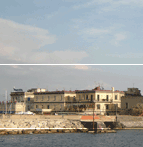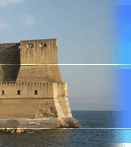Naples Heritage Tours Guide 2025: 2,500 Years of History
Naples stands as one of Europe's most historically significant cities, where 2,500 years of continuous habitation have created an unparalleled heritage landscape. From the ancient Greek settlement of Neapolis to the legendary Castel dell'Ovo with its mystical foundations, every stone tells stories of civilizations that shaped the Mediterranean world. Heritage enthusiasts will discover layers of history visible everywhere, from Roman ruins beneath modern streets to medieval castles guarding the harbor.
This UNESCO World Heritage city offers heritage tours that transport visitors through millennia of human achievement. The strategic importance of the Bay of Naples, protected by the legendary magic egg of Virgil hidden within Castel dell'Ovo, created a crossroads where Greek, Roman, Byzantine, Norman, and Spanish cultures left indelible marks on architecture, art, and daily life that remain vibrantly alive today.
Ancient Foundations: Greek & Roman Heritage
Castel dell'Ovo: The Legendary Beginning
Historical Significance: Built upon the ancient Isolotto di Megaride where the siren Parthenope was said to have washed ashore, Castel dell'Ovo represents the mythical foundation of Naples itself. The castle's foundations incorporate Roman villa ruins, while medieval and Renaissance additions create a unique architectural palimpsest spanning two millennia.
Heritage Tour Highlights: Expert guides reveal the layers of construction from Roman villa foundations to Norman fortifications, explain the legend of Virgil's magic egg that supposedly protects Naples, and provide access to areas showcasing different historical periods. The castle's strategic position offers unparalleled views for understanding Naples' geographical advantages that attracted successive civilizations.
Recommended Tours: Specialized castle tours focus on architectural evolution and archaeological discoveries, while sunset tours combine historical narrative with stunning views of the bay where ancient ships first brought Greek colonists to establish Neapolis.
Underground Naples: Hidden Roman Heritage
Napoli Sotterranea (Naples Underground): Beneath modern Naples lies an extraordinary network of Greek and Roman tunnels, aqueducts, and chambers that reveal the engineering prowess of ancient civilizations. These underground passages, carved from volcanic tuff stone, provided water supply systems and later served as air raid shelters during World War II.
Archaeological Significance: The underground tours showcase original Greek excavations from the 3rd century BC, Roman aqueduct systems that supplied ancient Neapolis, and medieval modifications that demonstrate continuous use throughout history. Visitors see authentic ancient construction techniques and understand how geography influenced urban development.
Tour Experience: Guided explorations include narrow passages requiring flashlights, preserved Roman-era chambers with original masonry, and explanations of ancient engineering solutions. The tours connect underground heritage with surface archaeological sites, providing comprehensive understanding of ancient Naples.
Medieval & Renaissance Heritage
Castle Tours: Norman to Aragonese Heritage
Castel Nuovo (Maschio Angioino): This imposing 13th-century fortress represents the height of medieval military architecture in Southern Italy. Built by Charles I of Anjou, the castle showcases the transition from medieval defensive structures to Renaissance palatial residences, housing important civic museums with medieval and Renaissance artifacts.
Heritage Features: The castle's triumphal arch demonstrates Renaissance artistic achievement, while the medieval chambers house frescoes and artifacts from various historical periods. Guided tours explain the political significance of Angevin and Aragonese rule in shaping Naples' cultural identity.
Castel Sant'Elmo: Perched on Vomero hill, this star-shaped fortress provides panoramic views while showcasing military engineering evolution from medieval to Renaissance periods. The castle's strategic position controlled access to the city and bay, demonstrating military thinking across centuries.
Religious Heritage: Sacred Architecture Through the Ages
Naples Cathedral (Duomo): The cathedral complex represents a millennium of sacred architecture, incorporating Gothic, Baroque, and Neoclassical elements. Most famous for housing the blood of San Gennaro, Naples' patron saint, the cathedral demonstrates the continuity of religious tradition through architectural evolution.
Heritage Significance: The cathedral's archaeological area reveals Roman and early Christian foundations, while the main structure showcases Gothic architecture adapted to Neapolitan preferences. The miracle of San Gennaro's blood liquefaction connects ancient martyrdom with contemporary faith.
Santa Chiara Monastery: This Gothic monastery complex features the famous majolica-tiled cloister representing unique Neapolitan artistic traditions. The monastery demonstrates monastic life through centuries while showcasing distinctive local artistic expressions in ceramics and architecture.
Specialized Heritage Tour Options
Archaeological Walking Tours
Roman Naples Trail: Expert archaeologists guide visitors through remnants of Roman Neapolis, including theater ruins, street layouts, and architectural fragments integrated into later buildings. These tours reveal how modern Naples preserves and incorporates ancient urban planning and construction.
Greek Heritage Route: Specialized tours focus on Greek foundations, including original city walls, ancient road systems, and archaeological sites that demonstrate the Greek colonial period. Guides explain how Greek urban planning influenced later Roman and medieval development.
Art & Cultural Heritage Tours
Caravaggio & Baroque Heritage: Art-focused tours explore Naples' crucial role in Baroque art development, including Caravaggio's masterpieces in historic churches and the city's influence on European artistic movements. These tours connect artistic heritage with historical context and patronage systems.
Renaissance Palace Tours: Private tours of historic palaces reveal noble family histories, architectural evolution, and decorative arts that demonstrate Naples' wealth and cultural sophistication during the Renaissance and Baroque periods.
Underground & Hidden Heritage
Catacombs of San Gennaro: These early Christian burial chambers represent the largest catacomb complex in Southern Italy, showcasing early Christian art and burial practices. Tours explain the transition from pagan to Christian burial traditions and reveal extraordinary frescoes and mosaics.
Galleria Borbonica: This underground tunnel system, built as an escape route for the Bourbon royal family, demonstrates 19th-century engineering while revealing layers of earlier construction. Tours explore both Bourbon history and earlier archaeological discoveries within the tunnel system.
Day Trip Heritage Extensions
Pompeii & Herculaneum: Preserved Roman Life
Archaeological Significance: These remarkably preserved Roman cities provide unparalleled insights into daily life during the height of the Roman Empire. Expert guides explain urban planning, domestic architecture, commercial systems, and social structures through perfectly preserved examples.
Recommended Tour Combinations: Full-day tours combining both sites with expert archaeological guides, specialized tours focusing on specific aspects like Roman domestic life or commercial systems, and photography tours capturing architectural details and preserved artworks.
Royal Palace of Caserta: Bourbon Heritage
Historical Context: This massive 18th-century palace complex represents the pinnacle of Bourbon royal architecture and demonstrates the wealth and ambition of the Kingdom of the Two Sicilies. The palace and gardens showcase European royal court culture and landscape architecture.
Heritage Value: UNESCO World Heritage recognition acknowledges the palace's significance in European royal architecture and garden design. Tours explore royal apartments, court life, and the integration of architecture with landscape design.
Expert Guide Services
Professional Archaeological Guides
Certified Expertise: Licensed archaeological guides provide scholarly interpretation of heritage sites, access to restricted areas, and detailed explanations of historical context and significance. These professionals ensure accurate historical information and deeper understanding of complex heritage narratives.
Specialized Knowledge: Expert guides offer focused tours on specific periods, archaeological discoveries, artistic movements, or architectural styles, providing depth that general tours cannot match. Many guides publish research and contribute to ongoing archaeological work.
Private & Group Tour Options
Customized Heritage Experiences: Private tours allow personalized focus on specific interests, whether architectural details, historical periods, or archaeological discoveries. Guides adapt explanations to visitor knowledge levels and interests.
Small Group Advantages: Limited group sizes ensure quality interaction with guides, access to areas unsuitable for large groups, and opportunity for detailed questions and discussion about heritage significance.
Heritage Photography & Documentation
Architectural Photography Tours
Technical Guidance: Professional photographers lead tours focusing on capturing heritage architecture, providing technical guidance for photographing historical buildings, and accessing optimal viewpoints for documenting architectural details.
Historical Context: Photography tours include historical explanations that enhance visual documentation, helping photographers understand and capture the cultural significance of architectural features and urban planning elements.
Educational & Cultural Programs
University-Level Heritage Courses
Academic Partnerships: Several institutions offer intensive heritage courses combining lectures, site visits, and hands-on archaeological experience. These programs provide scholarly understanding of Naples' role in Mediterranean cultural development.
Certificate Programs: Extended courses offer certificates in Mediterranean archaeology, art history, or cultural heritage management, providing professional development opportunities for serious heritage enthusiasts.
Family Heritage Programs
Educational Tours for Children: Specialized programs engage young visitors through interactive activities, storytelling, and hands-on experiences that make heritage accessible and exciting for family travelers.
Multi-Generational Learning: Tours designed for mixed-age groups provide different engagement levels while maintaining scholarly accuracy, ensuring both children and adults gain meaningful heritage understanding.
Related Heritage Resources
Enhance your heritage exploration with our specialized guides:
Booking Heritage Tours
Advance Reservations: Popular heritage tours, especially those with archaeological access or expert guides, require advance booking. Spring and fall seasons see highest demand for heritage-focused travel.
Seasonal Considerations: Heritage sites offer different experiences across seasons, with winter providing intimate access to indoor sites and summer offering extended hours for outdoor archaeological areas.
Group Size Limitations: Many heritage sites limit group sizes to preserve fragile archaeological areas and ensure quality educational experiences. Private and small group tours often provide the best heritage learning opportunities.
Naples' heritage tours offer transformative experiences that connect visitors with 2,500 years of human achievement. From the legendary foundations of Castel dell'Ovo to the perfectly preserved Roman cities nearby, every heritage experience deepens understanding of how this remarkable city shaped Mediterranean civilization and continues to preserve its extraordinary cultural legacy for future generations.









